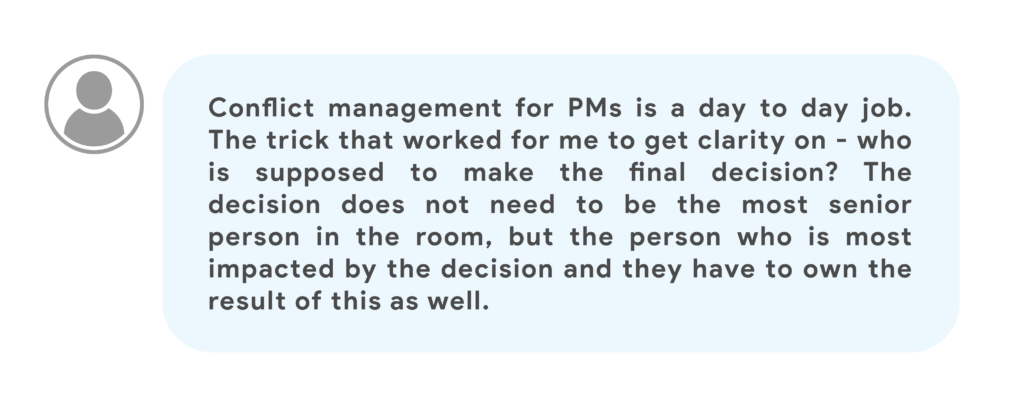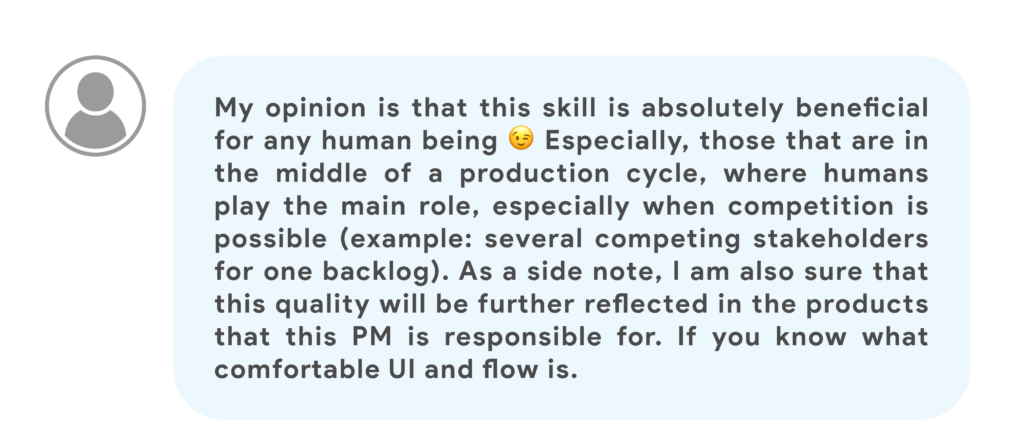Updated: June 18, 2025- 9 min read
Product Managers are leaders, whose day to day work involves moving in between cross-functional teams to drive product development. As you move up higher on the career ladder, more and more people management is involved. Your team members may have conflicting interests, vastly different perspectives, and different outcomes they want to achieve.
When you’ve got a lot of people (or even just a few people!) working closely together on something they all are heavily invested in, conflict almost seems inevitable.

What does this mean for you? Well, it means that you may find yourself running into people-related hurdles, which have nothing to do with bugs and glitches. Here, we’re going to show you what kind of conflicts you can expect to face as a Product Manager, how to handle them, and how to find the truth in them.
What Is Conflict Resolution in Product?
When we talk about conflict resolution in relation to Product Management, we don’t mean things like sexual harassment or discrimination – though those are certain things that must be dealt with swiftly and empathetically. Here, we’re talking about the day-to-day, nitty-gritty, ‘I’m going to pull my hair out’ conflicts that happen during development.
Different teams have slightly different goals. During development, compromises have to be made. For example, in a startup working on V1 of an MVP, a decision might have to be made between investing more in design early on, or focusing solely on functionality. The designers and engineers on either side of this will probably have differing strong opinions. Designers may want to create something more lovable and unique in order to gauge the market response, whereas the engineering team may be campaigning to put all resources into the technology.
In larger organizations, where you have conflicts may surface between management and teams. When tasks are handed down dictator-style with no opportunity for people to give feedback or offer an alternative, the wrong work gets done. Management feels like their employees are under-performing, and employees feel like they’re being punished for not achieving the impossible.
How to Resolve a Conflict, The Product Manager Way
1. Find the truth in the conflict.
You’re not a parent, trying to get squabbling children to calm down and stop throwing their toys at each other – you’re a manager trying to figure out why your employees disagree. Brushing over the conflict and just trying to get everyone to play nice, without investigating the root of the disagreement, is a recipe for disaster.
Maria Bykova, a Product Manger for Jimdo, offers an interesting perspective on why finding the truth in conflict is so important.
““I do believe in conflicts and the truth being found in conflicts. It is a common fallacy that people should not get involved in conflicts and the conflicts is something being seen as people shouting at each other or even fighting. Conflict is a disagreement or an argument people are having. You need them in order to make the decision, whether it comes to product management, people management, or any other job. I believe the key is resolving the conflict, listen to both parties, listening to their arguments and discussion, draw Pros and Cons and make an agreement with those parties.“”
You might also be interested in: Product Management Skills: Stakeholder Management

2. Be sensitive to unresolved conflict
If you sense that there’s a minor conflict bubbling up between teams/teammates, don’t let it fester under the surface. The root cause of the conflict may develop into something serious later on in development. Successful products need to be built on strong foundations, and a team showing cracks from day one will end up weakening development one way or the other.
Without being aggressive or overly confrontational, if you see a chink in the armor, give it a poke and see what falls out. Speak to those involved with the suspected conflict individually, and assess whether further action needs to be taken.
3. Be an active listener
Don’t just listen to your teams, hear them. When someone comes to you with a problem, listen to them, ask questions, and take time to think about what your response will be. Repeat the problem back to them, by saying things like, “just to make sure I’ve understood, you’re saying that…“
Take some time away to think about what the best solution is, and then come back to them about what you’re going to do about the problem. Taking this time to formulate a proper response will be much more well received than a simple “Don’t worry, I’ll handle it.” It also stops you from making promises you can’t keep just because you’re not sure how else to end the conversation.
You might also be interested in: How Soft Skills Can Save a Business
4. Scrap ‘it’s not personal, it’s just business.’
This mindset might have worked in Mad Men, but it doesn’t suit a Product Manager. You’re in a people-based role, and you have to treat your teammates like people. Not caring about bruised egos or wounded feelings is another recipe for disaster.
Treat your development team right, and they’ll treat your product right. (Being an active listener, which we’ve just gone over, is an important part of this.)
If you’re lucky and you’ve built up the right team, they won’t just be working for you because they need the money. They’re choosing to spend their talents building a great product with you because they care about the vision. Take that for granted and you might see them searching for a better place for those talents. High employee turnover is highly disruptive to product development and builds a bad reputation for your company in the tech world.

Moreover, as a Product Manager, influencing without authority is a huge part of your role. How can you expect to influence people and earn their trust if you haven’t been treating them well in times of conflict?
If you disagree with someone or take someone else’s side against theirs in a conflict, you still need to make it clear that you respect their input.
Tap into your Product Manager’s empathy, and don’t disregard feelings. Or in a worst-case scenario, your teammates may feel like going elsewhere.
5. Have regular document-based check-ins
We’ve said it so many times, but don’t laminate the roadmap! Certain things, like OKRs, KPIs, and of course the roadmap, are a critical part of product strategy. But they should also be collaborative. Getting the teams to routinely collaborate on these tools, will help you to achieve alignment early on.
When you lay out a roadmap or set OKRs that some people don’t agree with, you’re going to run into problems getting everyone to work together in harmony as development continues. Everyone wants to build a great product, so collaborating on a product roadmap together will ensure that everyone agrees on how you’re going to do that.
Keep going back to these documents, and check in with everyone on how things are going. This gives people an opportunity to highlight problems and offer up solutions. If something needs to be changed, better that it’s done sooner rather than later.
You may need to negotiate agreements and compromise on important features, but it’s better to do this at the start than having people be resistant to key aspects of development further down the line.
6. Have a contingency plan for crisis
Picture the scene… you walk into the office on a Monday and it feels like Doomsday. The engineering team has disappeared into a nearby conference room and is angrily muttering between themselves. You can hear the CTO raging in their office, papers are flying everywhere. Your lead UX designer is at their desk, furiously typing out what will surely be a scorcher of an email. Your APM looks at you, completely lost.
Does this sound too dramatic? Good. Plan for it!
If something goes horribly wrong during development and everything grinds to a halt, and the problem is product-based, it might fall on your shoulders to get things running again. When different teams come to a stalemate, figure out the best way to begin negotiations and get development back on track.
Speak to all parties involved individually, and get a 360 view of the conflict. Have a retrospective on what went wrong, why, and brainstorm possible solutions. It’s important to appear as impartial as possible, so no one feels like you’re taking sides.
One Step Further: Conflict Prevention

Conflict is less likely to occur when the development team is working in a collaborative environment where knowledge and data are democratized, and everyone feels safe sharing their ideas. That’s easy enough to say on paper, but actually putting in the work to make that happen is a long-term process.
The first step is to build conflict prevention into your hiring process. If time allows, take some time to let key team members meet potential candidates. Yariv Adan, a Product Lead at Google has a strong ‘no jerks’ policy, which helps to keep the teams motivated and helps to prevent conflict.
You can also help to prevent future conflict by being more than just a middle person. Depending on the hierarchical structure of your company, as a Product Manager, you’ll probably find yourself running interference between management and individual contributors. ‘They said X, and they said Y’ is a very dangerous game to start playing. Instead of seeing yourself as a reporter, try to think of yourself as a translator.
You need to empathize with the problems that your teams have, and help management understand them. You also need to understand the business needs of your company, and find a way to make these clear to your teams.
Use your product skills to go back to the ‘why’ of everything. Don’t just tell your product teams ‘management says do XYZ”, tell them the reasons why. Equally, don’t report back to management ‘engineering says they can’t do ABC.” Tell them the reasons why.
This sounds like an incredibly simple rule of basic communication, but it’s very easy to fire off a quick email without thinking, causing misunderstandings and setting up for future conflict.
You should also regularly review your communication processes, and keep an eye out for potential bottlenecks and silos. A communication breakdown is the perfect catalyst for conflict!
Have Your Say: Why Is It Important for Product Leaders?

We asked our community on Facebook, “How useful a skill is conflict resolution for Product Managers? Have you ever had to use it?”
The answer pretty unanimous. Conflict resolution is a daily experience for Product Managers.




![A great tip, when people make negative statements, say “what I heard was [repeat what they said]. It calms them by acknowledging their complaint and allows you to provide an alternative view](/_next/image?url=https%3A%2F%2Fimages.ctfassets.net%2F6nwv0fapso8r%2F4lQtyDyUFLQM7Eqk983n28%2F3bdf3d6f4e1df063e4c875c4573c1820%2FFB_Reply5-1024x330.png&w=2048&q=75)


Updated: June 18, 2025





